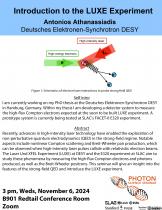SLAC, Redtail Hawk Conference Room 108A
Zoom
Join from PC, Mac, Linux, iOS or Android:https://stanford.zoom.us/j/95921881156?pwd=3CRElifPzTcKrrZ70yUXiTECPnndTo.1
Password: 487820
Or iPhone one-tap (US Toll): +18333021536,,95921881156# or +16507249799,,95921881156#
Or Telephone:
Dial: +1 650 724 9799 (US, Canada, Caribbean Toll) or +1 833 302 1536 (US, Canada, Caribbean Toll Free)
Meeting ID: 959 2188 1156
Password: 487820
Speaker: Antonios Athanassiadis
Program Description
Self intro
I am currently working on my PhD thesis at the Deutsches Elektronen-Synchrotron DESY in Hamburg, Germany. Within my thesis I am developing a detector system to measure the high-flux Compton electrons expected at the soon to be built LUXE experiment. A prototype system is currently being tested at SLAC’s FACET-II E320 experiment.
Abstract
Recently, advances in high-intensity laser technology have enabled the exploration of non-perturbative quantum electrodynamics (QED) in the strong-field regime. Notable aspects include nonlinear Compton scattering and Breit-Wheeler pair production, which can be observed when high-intensity laser pulses collide with relativistic electron beams. The Laser Und XFEL Experiment (LUXE) at DESY and the E320 experiment at SLAC aim to study these phenomena by measuring the high-flux Compton electrons and photons produced, as well as the Breit-Wheeler positrons. This seminar will give an insight into the features of the strong-field QED and introduce the LUXE experiment.





